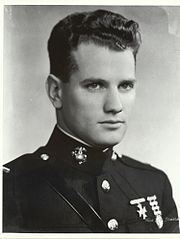Years of service 1938-1941 | Name George Cannon Rank First Lieutenant | |
 | ||
Allegiance United States of America Died December 7, 1941, Midway Atoll, United States Similar People Francis B Wai, Barney F Hajiro, Stanley Armour Dunham, Joseph Sarnoski, Madelyn Dunham | ||
First Lieutenant George Ham Cannon, USMC, (November 5, 1915 – December 7, 1941) was the first U.S. Marine in World War II to receive the nation's highest military award — the Medal of Honor.
Contents
He posthumously received the medal for "distinguished conduct in the line of his profession, extraordinary courage, and disregard of his own condition" during the bombardment of Midway Island by Japanese forces on December 7, 1941. He remained at his Command Post despite being mortally wounded by enemy shell fire. He refused to be evacuated until his men who had been wounded by the same shell were evacuated, and he continued to direct the reorganization of his Command Post until forcibly removed. He refused medical attention until he was assured communications were restored to his Command Post. As a result of his utter disregard of his own condition, he later died from loss of blood.
FIRST LIEUTENANT GEORGE H. CANNON
UNITED STATES MARINE CORPS
Biography
George Ham Cannon was born on November 5, 1915 in Webster Groves, Missouri. He later moved to Detroit, Michigan, where he graduated from Southeastern High School. He also attended the Culver Military Academy in Culver, Indiana, prior to entering the University of Michigan in Ann Arbor. While in attendance at that university he was a member of the Reserve Officers Training Corps, and graduated with a Bachelor of Science degree in Mechanical Engineering in June 1938.
He was commissioned a second lieutenant in the Engineer Reserve, U.S. Army during his last year in the University of Michigan. While at the University of Michigan he became a member of the Sigma Chi fraternity. He resigned his commission in the army upon graduation, in order to accept a commission as second lieutenant in the United States Marine Corps. Commissioned on June 25, 1938, he was ordered to duty on July 5, 1938, at the Philadelphia Navy Yard to await assignment to the next class of Basic School. He began studies on July 18, that year.
His first tour of duty as a U.S. Marine was on board the USS Boise, following the completion of his schooling May 20, 1939. He was assigned to the Post Service Battalion at the Marine Barracks, Quantico, Virginia, on July 10, 1940, and two weeks later entered the Base Defense Weapons Course at the Marine Corps Schools.
Ordered to the Marine Corps Base in San Diego, California, in December 1940, he joined Battery H, 2d Defense Battalion on February 16, 1941. In March 1941, the battery joined the 6th Defense Battalion and in July the unit sailed for Pearl Harbor. In August 1941, he was promoted to first lieutenant with the rank dating back to from June 25, 1941.
On September 7, 1941, 1stLt. Cannon reported to Midway Island as a platoon leader and member of the Battalion Coding Board. He was killed in action on the same day the Japanese drew the United States into World War II, December 7, 1941, during the sneak attack by Japanese forces.
After his burial on Midway, his remains were then removed to Halawa Cemetery in Hawaii, and from there to the Honolulu Memorial Cemetery ("Punchbowl"), where he is permanently interred.
Military awards
Cannon received the following military decorations and awards:
Medal of Honor citation
The President of the United States takes pleasure in presenting the Congressional MEDAL OF HONOR posthumously to
FIRST LIEUTENANT GEORGE H. CANNON
UNITED STATES MARINE CORPS
for service during an attack on the United States Fleet in Midway Islands as set forth in the following CITATION:
For distinguished conduct in the line of his profession, extraordinary courage, and disregard of his own condition during the bombardment of Sand Island, Midway Islands, by Japanese forces on December 7, 1941. Lieutenant Cannon, Battery Commander of Battery "H", Sixth Defense Battalion, Fleet Marine Force, U. S. Marine Corps, was at his Command Post when he was mortally wounded by enemy shell fire. He refused to be evacuated from his post until after his men, who had been wounded by the same shell were evacuated, and directed the reorganization of his Command Post until forcibly removed, and as a result of his utter disregard of his own condition he died from loss of blood.Lieutenant Cannon's actual Medal of Honor is the centerpiece in the display honoring the school's five Medal of Honor recipients at Culver Military Academy in Culver, IN.
